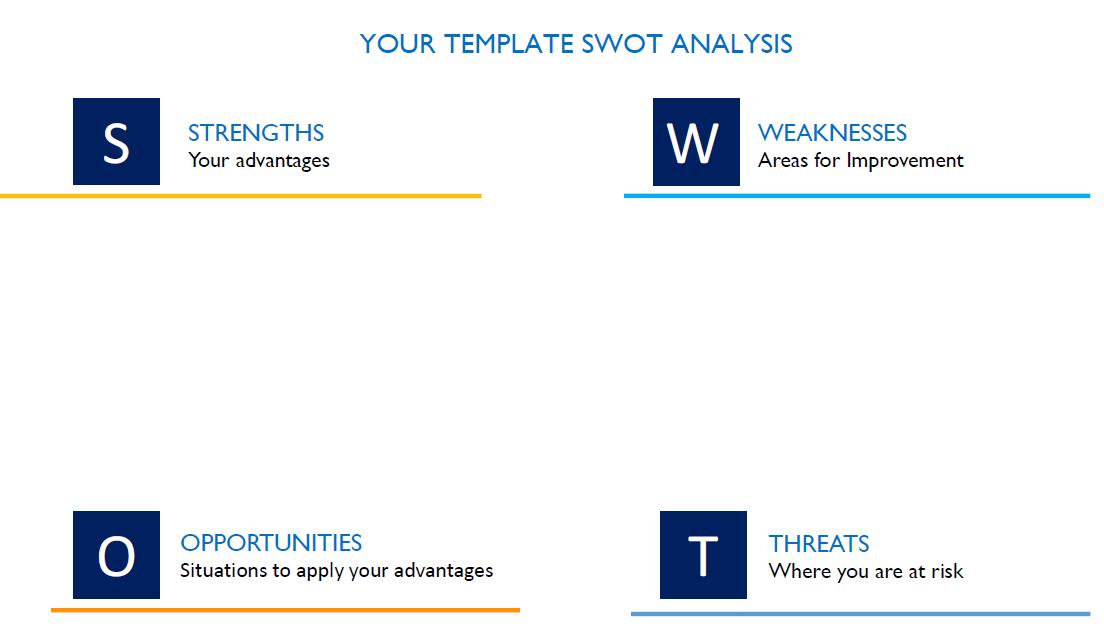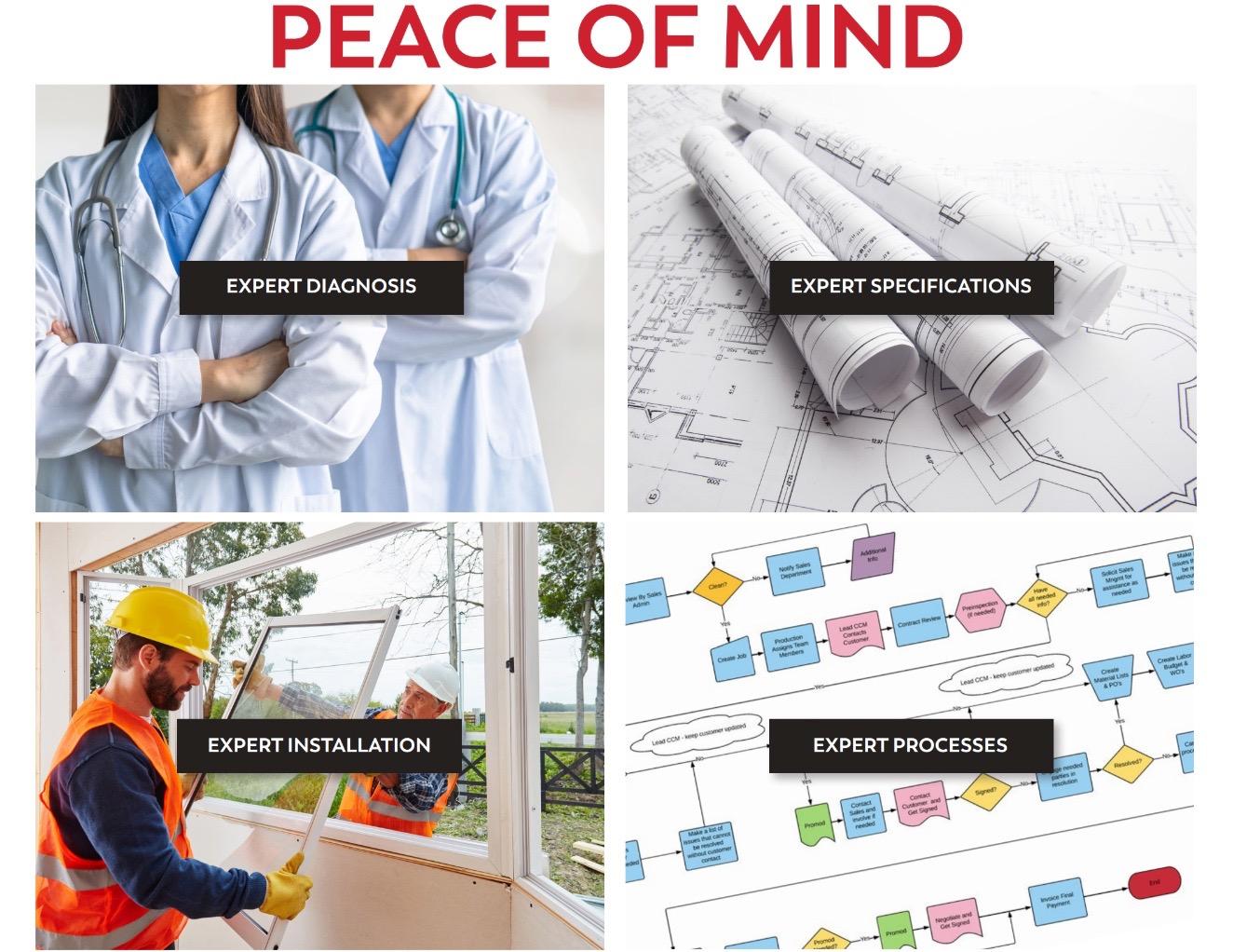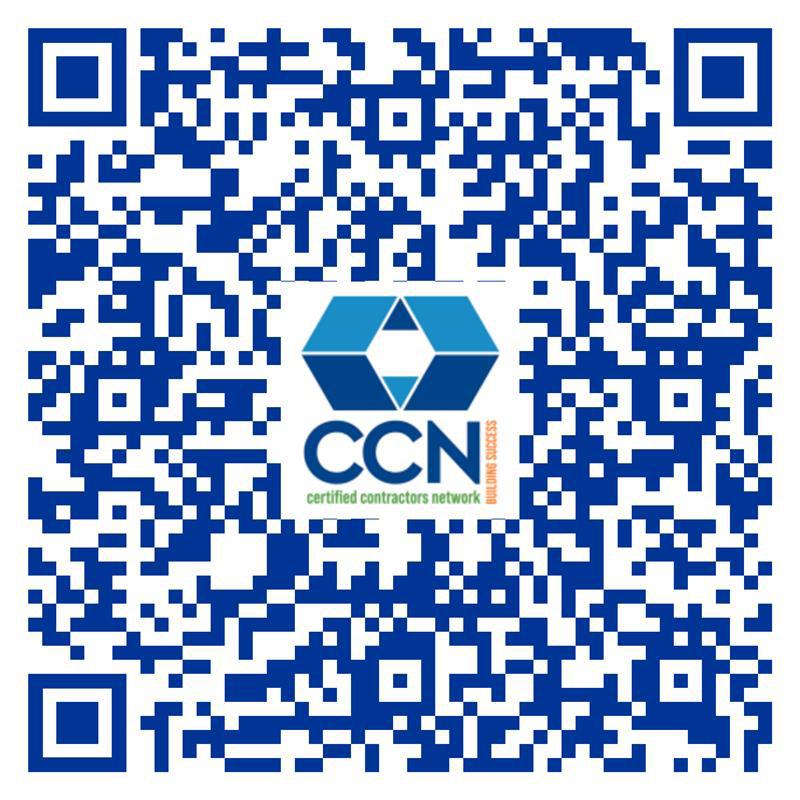The 6 Pillars of Success



In the dynamic world of home improvement contracting, success isn’t driven by a single factor. Instead, it demands a multifaceted approach encompassing all aspects of your business. At Certified Contractors Network (CCN), we emphasize that navigating this competitive landscape requires mastery of what we call the Six Pillars of Success: Marketing, Sales, Sales Management, Production, Operations, and Managing by the Numbers (KPIs). This eBook provides actionable takeaways for each pillar to help you scale revenues, gross profits, and net profits while delivering a world-class customer experience.
Effective marketing strategies lie at the foundation of any successful contracting business. Let’s look at key best practices in marketing. It’s not just about showcasing your services; it’s about crafting a compelling, Unique Value Proposition (UVP), a narrative that clearly differentiates you from your competition. This is about educating the customer to focus on value and not price, and this message must resonate with your target audience.
Before you can create your UVP, you need to go through an exercise and repeat it quarterly. Your business and the environment in which you operate are dynamic and not static, meaning updates and adjustments must be made along the way.
This exercise is a SWOT Analysis where you identify your company’s strengths, weaknesses, opportunities, and threats. This puts you in a much stronger position to craft your UVP. Second, you must do a deep dive to learn as much about your competitors as possible. You can accomplish this by researching their website, their social media channels, reading their reviews, and even blind shopping them. The better you get to know your competitors, the easier it will be for you to create a value proposition that is truly unique.
Utilize digital platforms to your advantage, harnessing the power of social media, websites, search engine marketing and optimization (SEO & SEM), and Google Pay-PerClick advertising to amplify your presence. Additionally, invest in traditional marketing channels such as flyers, brochures, canvassing, home shows, 5-5-10 radius marketing, and local media advertising to reach potential clients in your market. To do all of this effectively, you must highlight your company’s UVP, as it will clearly differentiate you from the competition.
By establishing a strong brand identity and consistently delivering a consistent message, you can cultivate trust and credibility among homeowners seeking your services. With a strong UVP, you will generate more leads, deliver more demos, and close more sales.
At CCN, we have seen many of our members improve their performance with a strong UVP. When our members focus on consistent marketing messages with a strong UVP, gross margins rise, and close rates increase.
Develop a Strong Unique Value Proposition (UVP): Conduct a quarterly SWOT analysis to identify your strengths, weaknesses, opportunities, and threats. Use this analysis to craft a compelling narrative that differentiates your business.
Know Your Competitors: Research competitor websites, social media channels, and reviews. Understanding their positioning helps you create a UVP that stands out.
Leverage Multi-Channel Marketing: Balance digital platforms like social media, websites, SEO/SEM, and PPC with traditional marketing channels such as flyers, canvassing, and local media advertising.
1. Conduct a quarterly SWOT analysis and update your UVP accordingly.
2. Utilize both digital and traditional marketing channels to reach your target audience.
3. Regularly engage with your community to strengthen brand recognition and trust.
4. Build customer personas and create tailored content to connect with your audience.

Things your company does well
Qualities that separate you from your competitors
Internal resources: skilled knowledgeable staff
Tangible assets: intellectual property capital, proprietary technologies
Emerging competitors
Changing regulatory environment
Negative press/media coverage
Changing customer attitudes toward your company
Economic conditions
Things your company lacks
Things your competitors do better than you
Resource limitations
Unclear unique selling propositions
Underserved markets for specific products
Few competitors in your area
Emerging need for your products or services
Positive press/media coverage of your company


Your goal is to continually increase the value of your brand.
Think about your “Brand Bank Account.”
Focus on increasing DEPOSITS and eliminating WITHDRAWS

Every day you and your employees are either increasing or decreasing the value of your brand
Be conscious of DEPOSITS and WITHDRAWS to your brand “ bank account.”
This is your brand equity.
Everything you and your team does impacts your brand!
Once your marketing efforts have piqued interest, it’s time to capitalize on opportunities through effective sales techniques. First and foremost, you must utilize a proven sales process, and every sales rep on your team should follow the same process. Listen intently to your client’s needs and desires, demonstrating empathy and understanding throughout the sales process. Ask open-ended questions, talk less, and listen more. This is the only way you can best understand a customer’s pain points and desires.
At CCN, we train our members on our 5P Sales Methodology. The 5Ps stand for Problems, Products, Processes, People, and Price. We have seen so many of our CCN members thrive with this 5P methodology, and it can be used for both one- and two-call closes. We highly recommend tailoring solutions that address the customer’s specific concerns, highlighting the value proposition of your services. Remember, effective selling isn’t about pushing a product; it’s about building relationships and fostering trust. Remember, your customers are not buying a new roof, siding, kitchen, or bath; they are buying the best contractor for them, and that should be you. By adopting a consultative approach and focusing on customer satisfaction, you can transform inquiries into lucrative contracts.
1. Who is Certified Contractors Network?
2. What criteria are required for Contractor Selection & Qualification?
3. What is the proper design or scope of work for your project?
4. What are the specifications that will achieve the scope of work?
5. What are the risks and liabilities of uninsured or underinsured contractors?
Questions You Should Ask:
1. What are the preparation requirements that impact long-term performance?
2. What are the proper materials for the project?
3. What styles, options, grades, and warranties are available?
4. What are the craftmanship requirements?
Questions You Should Ask:
1. How does the contractor ensure what you agreed upon is actually delivered?
2. What is the contractor’s communication process?
3. Are the owners available to address any concerns?
4. How does the contractor ensure you will have a great customer journey?
Questions You Should Ask:
1. Is the contractor licensed?
2. Who will be responsible to perform the work?
3. How long has the contractor been in business?
4. Can the contractor provide references?
5. Why choose this specific contractor?
Questions You Should Ask:
1. How do you determine if the price is right?
2. Has the contractor worked nearby for price comparison?
3. What happens when something arises that wasn’t planned?
4. What are your options for funding your construction investment?
5. Is the proposal clear and understandable?

Follow a Proven Sales Process: Ensure every sales rep adheres to a consistent methodology. CCN’s 5P Sales Methodology (Problems, Products, Process, People, Price) offers a reliable framework.
Adopt a Consultative Approach: Listen intently to customer needs, ask open-ended questions, and tailor solutions to their pain points.
Build Trust: Focus on relationship-building, emphasizing your value proposition and reliability.
1. Train your sales team to consistently use a tried-and-true sales methodology. Of course, we recommend the 5P Sales System.
2. Utilize CRM tools to manage leads and ensure consistent follow-up.
3. Incorporate testimonials and case studies to build trust and credibility.
4. Develop sales collateral to enhance presentations and improve customer understanding.
An effective sales process will funnel all customer objections into just a few predictable objections.
Below is a road map to overcoming objections effectively, leading to more sales.
MAJOR PRICE OBJECTION
Terms Trial Close
Lie Detector
Clarifying Question
Acknowledge the Objection
Competitive Edge
Consultants Hat
Warranty Question
My Mentor
Reducing to Final Objection
“I WANT TO THINK IT OVER”
Terms Trial Close
Difficult Decision
Lie Detector
Comparision Question
Clarify the Objection
Reducing to Final Objection
“GET ANOTHER PRICE”
Terms Trial Close
Lie Detector
Clarify the Objection
Community Based Contractor
What will You Find
Reference Book Speech
Establish Trust and Confidence
Managing a sales team requires a delicate balance of leadership, motivation, and accountability. At CCN, we train our members’ sales managers to focus on beliefs, behaviors, and skills. This means it is the sales manager’s job to build the belief system within each sales rep. They truly must believe in your company and that your company offers the best and most reliable solutions. Finally, it is the sales manager’s responsibility to raise the bar on each sales rep’s skills. Set clear objectives and expectations for your sales representatives, providing them with the tools and resources needed to excel. Implement regular training sessions and role plays to hone their skills and improve their close rates. Additionally, establish metrics to track performance, allowing you to identify areas for improvement and celebrate successes. By fostering a culture of collaboration and continuous improvement within your sales team, you can drive sustained growth and profitability.
Our CCN members who drive home the concept of beliefs, behaviors, and skills, are the same members who are seeing stronger sales performance.
Focus on Beliefs, Behaviors, and Skills: Help sales reps believe in your company’s mission and offerings. Provide continuous training to refine their skills and behaviors.
Set Clear Objectives: Define measurable goals and provide resources for success.
Regular Training and Role-Playing: Enhance skills and improve close rates through ongoing development.
1. Build a strong belief system within your sales team about your company’s unique value.
2. Implement weekly one-on-ones to mentor and motivate your team.
3. Use performance-based incentives to drive results.
4. Host workshops and develop a resource library to continually elevate team performance.
At CCN, we believe that without proper beliefs, everything else is just window dressing. Here is a valuable exercise that sales managers can do to ensure that their sales teams’ beliefs are where they need to be in order to effectively and consistently sell profitable jobs
Write and honest assessment of where you are today and where you want to go to build beliefs wit hyour team, and then discuss it wth your group.
Beliefs Exercise - 20 minutes
Write an honest assessment of where you are today and where you want to go to build Beliefs with your team, and then discuss it with your group.
What are you currently doing in sales meetings to build beliefs in your sales reps?
What are you currently doing to build beliefs in knowing what is possible?
What are you currently doing in the area of group texts to the sales team to build beliefs?
What are you doing with the compensation structure to further build beliefs in your sales reps?
What are you currently doing in appointment debriefs to build beliefs in your sales reps?
What are you currently doing with your sales reps to build belief in your company's values?
Stories and Examples
Are you successful in using stories and examples to build beliefs among your sales team? If so, how?
The heart of any contracting business lies in its ability to deliver exceptional results on time and within budget (profitably). The production team needs to hone their skills too, and we are not just talking about expert installation. They should be building strong firewalls, improving their scheduling process, improve conflict resolution and communication with the customer. Cultivate a production team of skilled professionals who take pride in every aspect of their work, from the time sales hands off the job to them, and deliver a world-class customer experience, ensuring that every project meets the highest standards of quality. Implement efficient workflows and project management systems to streamline operations and minimize delays. Again, communicate openly and transparently with clients throughout the production process, keeping them informed of progress and promptly addressing any concerns. By prioritizing excellence in every aspect of production, you can earn rave reviews and referrals that fuel your business’s success.
We have many CCN members who are seeing more 5-star reviews and repeat and referral business. It is critically important to focus on excellence in every aspect of production.
Build Operational Firewalls: Ensure seamless transitions from sales to production with clear processes.
Enhance Communication: Keep customers informed at every project stage to build trust and address concerns proactively.
Focus on Excellence: Cultivate a team dedicated to delivering high-quality results on time and within budget.
1. Develop efficient workflows to streamline production and minimize delays.
2. Communicate transparently with clients to enhance satisfaction and build loyalty.
3. Celebrate team successes to maintain morale and focus on excellence.
4. Implement quality assurance measures and document lessons learned for continuous improvement.
Customer satisfaction is generally at its peak the day the project is completed. We encourage every company to do a final walk-through with the customer utilizing a Zero Defects checklist to help assure the customer is 100% satisfied with their project. Using a form like the one below will help with the walk-through and prevent future customer dissatisfaction.

Date:
Scope of work reviewed with customer?
25Final payment received? Removal complete?
Deck/substrate inspection complete?
Tear-off
Installation progress pictures taken?
Install
Install Spec: Correct starter installed?
Install Spec: Correct j-channel?
Install Spec: Correct nailing pattern?
Install Spec: Any raised fasteners?
Install Spec: Correct mount masters?
Install Spec: Correct shutters?
Install Spec: Correct sealant(s)?
Install Spec: Correct soffit installed?
Install Spec: Correct fascia installed?
Final Walkthrough with Customer?
26Final pictures taken?
27Survey Request/Podium Complete? Rev 09/13/2024
Behind the scenes, meticulous attention to operational details is essential for sustained success. From office management to procurement, logistics to scheduling, and resource allocation, every aspect of your business must operate like a well-oiled machine. Embrace technology to automate repetitive tasks and streamline administrative processes, freeing up valuable time and resources. Regularly assess and optimize your operations to identify inefficiencies and implement improvements. By maintaining a sharp focus on operational excellence, you can enhance productivity, minimize costs, and maximize profitability.
At CCN, we teach a Business Operations course that provides an in-depth system for running a smooth operation. So many CCN members have mastered critically important functions through these trainings, including Total Quality Management (TQM).
Embrace Technology: Automate administrative tasks and integrate project management tools to enhance efficiency.
Regularly Evaluate Processes: Conduct routine assessments to identify inefficiencies and implement improvements.
Adopt Total Quality Management (TQM): Use TQM principles to standardize excellence across operations.
1. Use technology to streamline operational tasks and improve efficiency.
2. Develop and regularly update SOPs to maintain consistency.
3. Build strong vendor relationships to optimize costs and resources.
4. Conduct cross-training to create a flexible and resilient team.
Operations is the heartbeat of an effective company. A high-functioning operations team should have documented processes and procedures. Below is a cheat sheet for an effective sales-to-production hand-off process that will help ensure 100% customer satisfaction.
In the dynamic world of home improvement contracting, data-driven insights are invaluable for informed decision-making. Establish key performance indicators (KPIs) that align with your business objectives, allowing you to measure progress and identify areas of opportunity or concern. Monitor critical metrics such as conversion rates, project profitability, and customer satisfaction scores to gauge your business’s performance effectively. Leverage advanced analytics tools to analyze trends and forecast future demand, empowering you to adapt proactively to changing market conditions. At CCN, many of our members found that our Managing by the Numbers course does a great job of helping them create a dashboard with key metrics that drive datadriven decision-making.
CCN created the Virtuous Cycle of Success for improving your company’s KPIs, a continuous loop of 8 steps contractors go through with every contract we win and produce.

1. Branding and Marketing – It is difficult to generate leads with no branding or marketing. It all starts with marketing, where we create brand awareness, communicate our unique value proposition, choose our messaging for our target market, and pique enough interest to generate leads.
2. Call Center & Lead Processing – Your call center handles inbound leads. If you do not have a call center, you more than likely have a person responsible for reaching out to these leads. We need to master the best practices in our call center to maximize the number of appointments set and confirmed.
3. Sales and Sales Management – After appointments are set for sales reps, the responsibility for these leads is then transferred to them. Sales reps must master your sales process exactly as it is and not tweak it. If any or all sales reps make personal tweaks to the sales process, then your company is no longer following a set process and sales conversions will suffer.
4. Pre-Production and Firewalls – These are critical components of a successful home improvement contracting business. These processes bridge the gap between the sales stage and project execution, ensuring that everything is in place to deliver a smooth, efficient, and high-quality project.
5. Production – This is where the work gets done. It’s the phase where the vision laid out in contracts, designs, and plans becomes a tangible outcome. This is where your company is hopefully delivering a world class customer experience while operating with maximum efficiency.
6. Post-Production, TQM and a CX Feedback Loop – These are crucial for ensuring long-term customer satisfaction, building trust, and securing repeat business and referrals. This phase allows contractors to refine their processes, enhance customer relationships, and differentiate their business in a competitive market.
7. Financial and KPIs Review with Takeaways – Success isn’t just measured by the number of projects completed or revenue generated. It’s about profitability, efficiency, and sustainability. This step is essential for understanding the health of your business, identifying opportunities for improvement and making data-driven decisions. When coupled with actionable takeaways, these reviews become a powerful tool for growth and long-term success.
8. Root Cause Analysis and Action Plan – This step is essential for addressing procedural gaps and driving meaningful, lasting improvements in your business. This process goes beyond identifying surface-level issues by uncovering the underlying causes of problems and implementing targeted solutions.
Your goal is to focus on the micro-improvements you can make in each of these 8 steps each time you travel through the Virtuous Cycle of Success. This can be done with each and every customer journey through these steps. When you repeatedly make micro-improvements throughout the year, you will generate macro-results! Remember that this is a continuous cycle of success where you continue “rinse and repeat,” and it never stops, as we will never reach perfection, but we can make continuous improvements in all 8 steps. CCN members who have embraced this tool have seen revenue scale and EBITDA as a percentage of revenue grow.
It is critically important to track KPIs in several areas of your company. Here is a good starting point:
The challenge is that there are endless amounts of KPIs to track and data to analyze. Below is an overwhelming, but non-exhaustive list:
n Inbound Leads by Source
n Inbound Leads by Product Line
n Inbound Leads by Zip Code
n Contact Rate (Leads Contacted /Total Opportunities)
n Set Rate (Appointments Set / Leads Contacted)
n Issued Rate (Confirmed Appointments / Appointments Set)
n Measure Call Rate (Measure Calls Completed / Leads Issued) **
n Demo Rate (Demos Completed / Leads Issued)
n Demo Rate (Demos Completed / Measure Calls Completed) **
n Close Rate (Contracts Closed / Leads Issued)
n Net Sales Per Leads Issued or NSLI (Net Sales / Leads Issued)
n Finance Rate (# of Financed Jobs / Total # of Jobs Sold)
n Financed Average Job Size vs. Non-Financed Average Job Size
n Cancellation Rate (# of Cancellations / # of Contracts)
n Monthly Sales by Product Line (MTD & YTD / Goal & Prior Year)
** For Companies with a 2-Call Close
n Capacity Modeling & Capacity Utilization Tracking
n 1st Pass Yield (Throughput Yield)
n Customer Satisfaction (NPS or Guild Quality LTR)
n Throughput (Billings Compared to Goal)
n Gross Margin by Product Line, Per Job / Relative to Goal (By Margin/Day/Crew)
n Budget vs. Actual for Every Job
n Job Costing by Job and by Product Line
n Collections (A/R)
n Monthly P&L Review (Accrual Basis & GAAP Compliant)
n Monthly Balance Sheet Review
n Marketing, Sales & Production Funnels Review Relative to Goal
n Cash Balances and Cash Forecast
n Accounts Receivable and Accounts Payable Review
n Working Capital Requirement
n Gross Margin % (Gross Profit/Net Sales x 100) Target: 45%-60%
n Net Income % ((Revenue – Total Expenses)/Revenue) Target: 10% or more
n Debt to Equity Ratio (Total Debt / Total Shareholders’ Equity) Target: ≤ 2.0
n Debt to Asset Ratio (Total Debt / Total Assets) Target: ≤ 0.6
n Debt to EBITDA Ratio (Total Debt / EBITDA) Target: ≤ 3.0
n Current Ratio (Current Assets / Current Liabilities) Target: ≥ 1.5
n Quick Ratio ((Current Assets – Inventory) / Current Liabilities) Target: ≥ 1.0
As a starting point, we suggest a few critical KPIs for each area of the business that require mastery first, see below:
Total Leads/Inquiries
Cost Per Lead
% of Out-of-scope leads
Marekting Cost as a % of Revenue
Service Level
Contact Rate
Appointments Set
Appointment Sat
Demo Rate
Closes/Contracts
Revenue per Appointment (RPA)/Net Sale per Lead Issued (NSLI)
First Pass Yield
Gross Margin
Net Promoter Score/Likely to Recommend
Overhead Percentage (SG&A) (on installed revenue)
Net Profit Percentage (GAAP)
Define and Track KPIs: Align metrics with business goals, such as conversion rates, project profitability, and customer satisfaction scores.
Leverage Analytics Tools: Use data to analyze trends and forecast demand, enabling proactive strategy adjustments.
Create Dashboards: Develop visual dashboards to monitor critical metrics at a glance.
1. Identify and focus on key performance indicators that drive your business forward.
2. Use analytics to predict market trends and adapt strategies accordingly.
3. Train your team to interpret and act on data insights.
4. Conduct scenario planning and financial reviews to remain agile and proactive.
Mastering CCN’s Six Pillars of Success requires dedication, expertise, and a relentless commitment to excellence. By embracing these best practices and focusing on continuous improvement, you can achieve sustained growth, increased profitability, and a reputation for delivering unparalleled customer experiences. Let the insights from this eBook serve as a roadmap to thriving in the competitive home improvement contracting industry. Keep in mind that this eBook is a high-level overview of CCN’s 6 Pillars of Success. Each of these pillars is a comprehensive course in CCN’s training curriculum.


